- “Currently, This Hardware Device Is Not Connected to the Computer”: What Does It Mean?
- What Causes the Error “Code 45” in Device Manager?
- How to Fix “Currently, This Hardware Device Is Not Connected to the Computer. (Code 45)”
- Solution 1: Restart Windows
- Solution 2: Check and reconnect your device
- Solution 3: Disable and re-enable the device
- Solution 4: Manually uninstall and reinstall your device driver
- Solution 5: Update related device drivers
- Solution 6: Check for Windows updates
- Solution 7: Apply default BIOS settings
- Solution 8: Use the default Windows Hardware and Devices troubleshooter
- Solution 9: Resolve system file issues with the DISM tool and System File Checker
- Solution 10: Check the system drive with the CHKDSK command
- Specific Device Issues and Solutions for “Code 45”
- “Code 45” in Device Manager: Fixed
- FAQ
Any number of issues can manifest on a Windows computer. But a hardware device that suddenly stops working for no obvious reason can be especially inconvenient. Device Manager’s “Code 45” error is a rather popular issue that has given many Windows users such a hard time.
Under normal circumstances, the “Currently, this hardware device is not connected to the computer. (Code 45)” message only indicates that an installed device is currently not connected to the computer.
But in certain cases, when the device is actually connected, this error still turns up.
Even the built-in devices on a PC, namely the keyboard, speakers, webcam, Bluetooth adapter, network adapter, and graphics devices such as NVIDIA, could show “Code 45” in Device Manager, thereby making things very difficult for the user.
If you count among those looking for how to fix “Code 45” on your Windows PC, your search may be over. We’ve curated multiple possible solutions in this guide, which you’d find helpful.
-
🔌 Perform a power flush and restart your PC.
-
🔗 Reconnect the device.
-
🌐 Perform a network reset, and temporarily disable the firewall to check for wireless connection issues.
-
🛠️ See that the device is enabled in the BIOS/UEFI settings.
-
🔄 Re-enable the device in Device Manager.
-
🚀 Update your device drivers.
-
🧹 Run a DISM/SFC scan to fix system file issues.
-
🧱 Run a CHKDSK scan to fix system drive issues.
-
🕵️♂️ Run the Devices troubleshooter in the Settings app or your PC maintenance app’s troubleshooter.
-
♻️ Restore the default BIOS/UEFI settings.
-
🆙 Update the BIOS/UEFI firmware.
-
🔎 Check for hardware damage.
“Currently, This Hardware Device Is Not Connected to the Computer”: What Does It Mean?
The “Code 45” error in Device Manager is a status description for a listed device that is no longer functional on your Windows PC. It is seen in the Properties dialog box when you right-click on the said device and select Properties.
The status for a functional device should read, “This device is working properly.”
But if you are seeing the “Currently, this hardware device is not connected to the computer. (Code 45)” status instead, that’s to tell you that the device in question is either not properly connected or that the system, for some reason, cannot recognize it anymore.
What Causes the Error “Code 45” in Device Manager?
Under normal circumstances, “Code 45” doesn’t require you to resolve it. It should resolve automatically when you reconnect your device to the computer.
However, if it still occurs, even for built-in hardware devices, it might be a temporary system glitch that a simple restart of your PC would get rid of. Otherwise, the recurring “Code 45” error may be due to a number of possible reasons, such as:
- Faulty or outdated driver
- Corrupt or missing Windows system files and registry keys
- Damaged or faulty hardware
But not to worry, no matter what the case may be for you, the solutions presented here will enable you to get rid of the error “Code 45” for good.
| Error “Code 45” possible causes | Solutions |
|---|---|
| Disconnected device |
|
| System glitch |
|
| Disabled device/permission settings | |
| Faulty/outdated device drivers | |
| Windows bugs and system file issues | |
| System drive issues | |
| Outdated BIOS firmware and suboptimal BIOS settings | |
| Hardware issues |
|
How to Fix “Currently, This Hardware Device Is Not Connected to the Computer. (Code 45)”
Without further ado, let’s get started.
Here’s how to fix “Code 45” on Windows 10/11:
Solution 1: Restart Windows
Restarting Windows is usually advertised as a one-stop solution for many software (and even hardware) problems, including the error “Code 45.”
This is valid because restarting your Windows computer lets it shut down its processes, cool down, and start over.
In addition, performing a power flush (also known as a hard reset) often helps to fix certain system issues and may prove useful in getting the “Code 45” error to go away.
It involves unplugging the PC from the power source, removing the battery, and then pressing and holding the power button for 20–30 seconds to drain the residual power.
Afterward, the system may now recognize the device you are trying to connect and allow you to use it. But if it still doesn’t work, proceed with the next solution.
Solution 2: Check and reconnect your device
The error “Code 45” in Device Manager is a connectivity issue. So, inspect your device to see if there are any physical switches or hardware abnormalities.
Check the cables, if it uses one, to ensure that they’re fitted properly.
If there are no cables, then check whether there’s something interfering with your connection, such as your PC’s firewall. Try disabling the firewall temporarily to confirm whether the settings are interfering with drivers. That could make all the difference.
Also, try connecting the device to another PC to see if it works. If it does, then proceed with the solutions presented below.
Solution 3: Disable and re-enable the device
A minor glitch may be causing your device not to work. Simply re-enabling the device might suffice in getting rid of the error “Code 45”:
- Click the Start button and type Device Manager in the search bar. Then open the app from the search results.
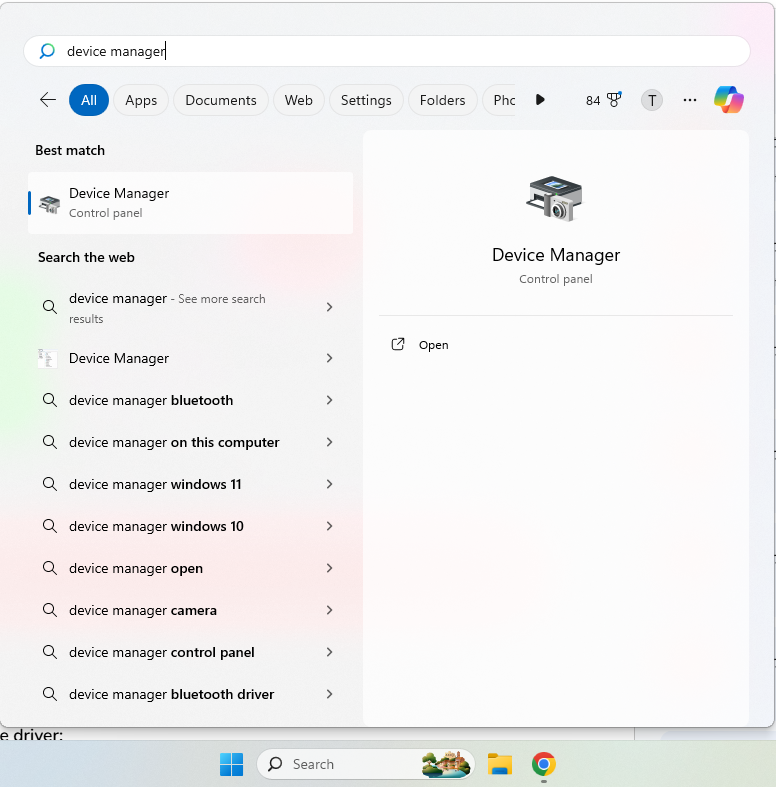
- Locate the problematic device and right-click on it.
- Click on Disable device and click Yes to confirm the action.
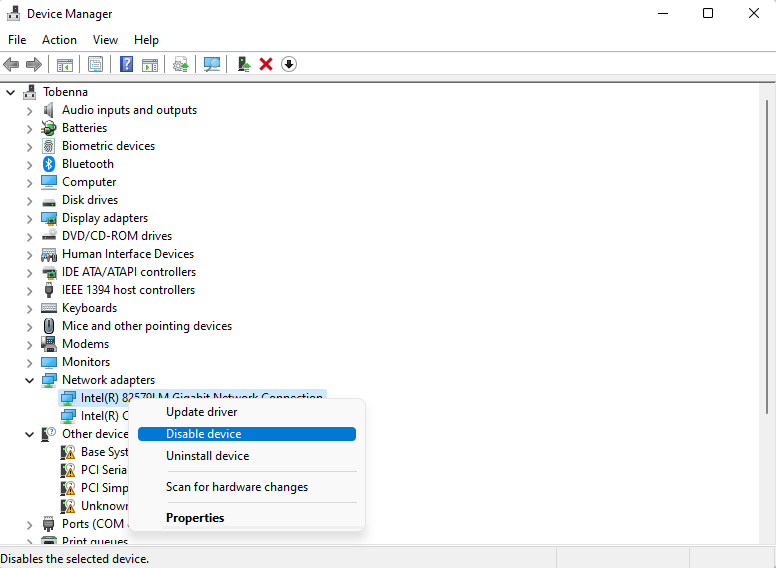
- Restart your computer.
Now, all you have to do is go back to Device Manager, right-click on the device once again, and click on Enable.
Solution 4: Manually uninstall and reinstall your device driver
When the “Currently, this hardware device is not connected to the computer. (Code 45)” error happens, especially with a built-in device on your PC, that’s a strong indication that you’re dealing with a software issue, notably the device driver.
Therefore, the first thing you should do in this regard is to uninstall the problematic driver via Device Manager, and then scan for hardware changes to reinstall the driver:
- Open the Run dialog (
Windows + R). - Type devmgmt.msc and hit
Enter.
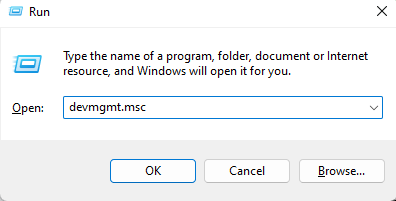
- Locate the problematic device and right-click on it.
- Click on Uninstall device.
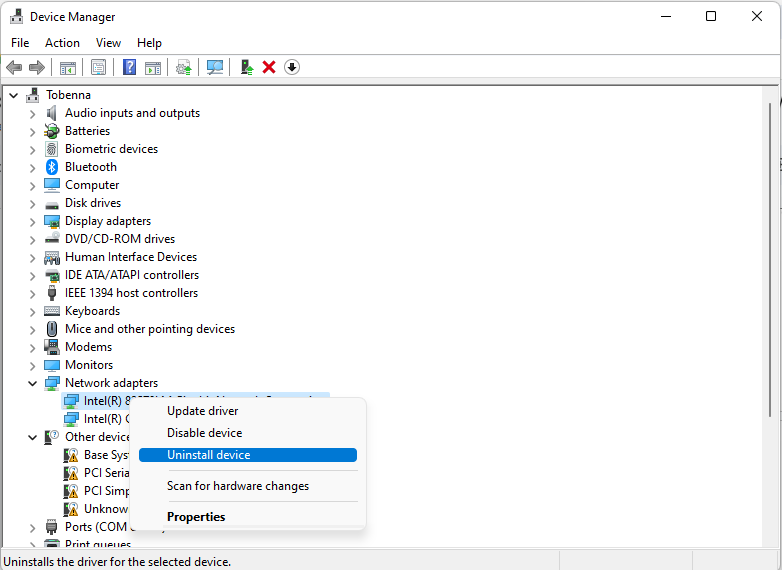
- Enable the Delete the driver software for this device option (or Attempt to remove the driver for this device).
- Click Uninstall.
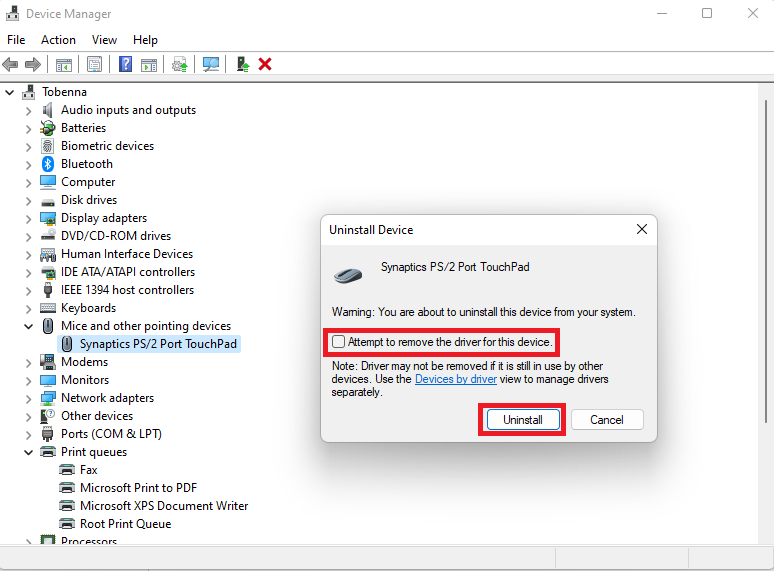
- After the uninstallation is done, restart your computer.
- Go back to Device Manager and switch to the Action tab.
- Click on Scan for hardware changes to let the system detect absent drivers and attempt to install them.
- Restart your PC when the process is complete.
Move on to the next solution below to ensure that you obtain the necessary driver for your device.
Solution 5: Update related device drivers
Reinstalling your drivers by scanning for hardware changes in Device Manager will only install the generic driver version, if it succeeds at all. The best way to get the latest driver would be through the device manufacturer’s website.
If you are dealing with a built-in device, that would be the website of the computer manufacturer, for example, HP or Dell.
Furthermore, a dedicated third-party driver updater app, such as Auslogics Driver Updater and Driver Easy, will easily get the drivers for both the built-in and installed devices that are connected to your PC. These tools often offer the following advantages over manufacturer applications:
- They can back up your drivers so that you can initiate a rollback if needed.
- They can run scheduled scans to catch driver issues before they lead to errors like Device Manager’s “Code 45.”
- They can automatically install the latest official drivers in batches.
Solution 6: Check for Windows updates
Regularly checking for and installing new Windows updates is a recommended maintenance procedure for keeping your PC optimized. It keeps certain hardware support drivers up to date and ensures other critical components are available. It also helps fix bugs and other system issues that could cause unforeseen errors, such as Device Manager’s “Code 45”:
- Open the Settings app (
Windows + I) on your PC. - Click on Windows Update (Update & Security > Windows Update in Windows 10) in the left pane.
- Click the Check for updates button and wait for the tool to find new updates.
Ensure that you prompt it to download and install all of them.
Solution 7: Apply default BIOS settings
The BIOS is responsible for initializing hardware devices, particularly components directly connected to the motherboard. Changes in the BIOS can lead to the error “Code 45” in some cases, and reverting to default settings can resolve the issue.
The following steps will give you a general idea on how to fix “Code 45” in Windows 10 and 11 through the BIOS/UEFI:
- Open the Start menu, click the power icon, then hold the
Shiftbutton and click Restart. - When you get to the Choose an option screen, select Troubleshoot > Advanced options and select UEFI Firmware Settings.
- Once you enter the BIOS environment, tap the keyboard button indicated for restoring defaults. This may differ according to your PC or motherboard.
- Once done, select the option that takes you out of the BIOS and saves your default settings (usually,
F10).
Solution 8: Use the default Windows Hardware and Devices troubleshooter
Windows’ built-in Hardware and Devices troubleshooter can resolve the error “Code 45” if the affected device is connected but isn’t recognized by Windows due to driver initialization problems or temporary conflicts. Windows allows you to choose from different troubleshooters within the same framework, depending on the affected device.
I’ll show you how to run the troubleshooter in Windows 10 and 11.
Microsoft is phasing out the MSDT troubleshooters in Windows 11 and has already integrated the legacy processes into the Get Help app. However, the new mechanism is now limited to fewer devices in Windows 11. I’ll show you how to use the latest Windows 11 troubleshooter and the legacy wizard.
Follow these steps to troubleshoot common hardware devices in Windows 11:
- Press the
Windows + Ikeyboard shortcut to open the Settings app. - Select System on the left pane.
- Scroll down the main window to locate and click on Troubleshoot.
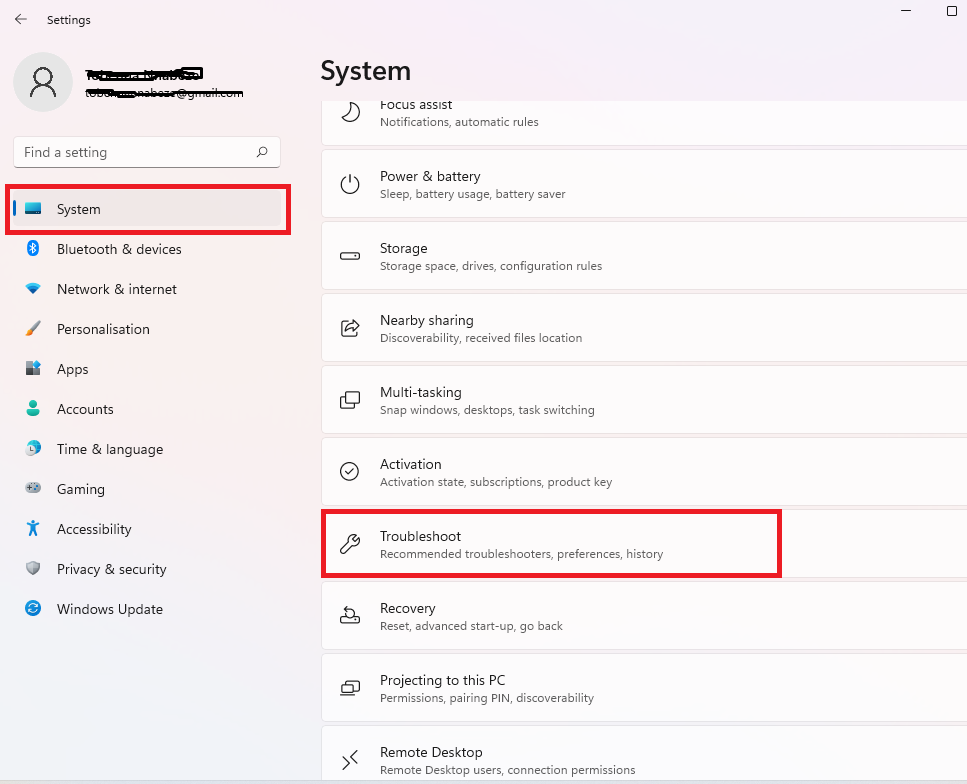
- Click on Other troubleshooters.
- Scroll through the list to find your problematic device and click the Run button to start the troubleshooter.
- Windows will now display the Get Help platform. Click Yes to allow the program to run diagnostics and follow the subsequent prompts.

Here’s how to use the legacy wizard:
- Press the
Win + Rkeyboard shortcut. - Copy and paste the following command into the text field and hit the
Enterkeyboard button:
msdt.exe -id DeviceDiagnostic

- Click Next when the troubleshooter appears.

- Apply the fixes it recommends.

Afterwards, check whether “Code 45” in Device Manager has been resolved and see if your device now works as expected.
Therefore, you can use them additionally. They will also come in handy if it ever happens that you can’t find a troubleshooter for your device in Control Panel or in the Settings app.
Here’s how to fix “Code 45” in Windows 10 using the appropriate troubleshooter as it exists in Control Panel:
- Click the Start icon on the taskbar.
- Type Control Panel in the search bar and click the option to open it.
- Press
Ctrl + Eto use the search bar that pops up in the top-right corner of the Control Panel window. - Enter troubleshooting into the search tab and press
Enteron your keyboard.

- In the Troubleshoot computer problems window, click on Hardware and Sound.
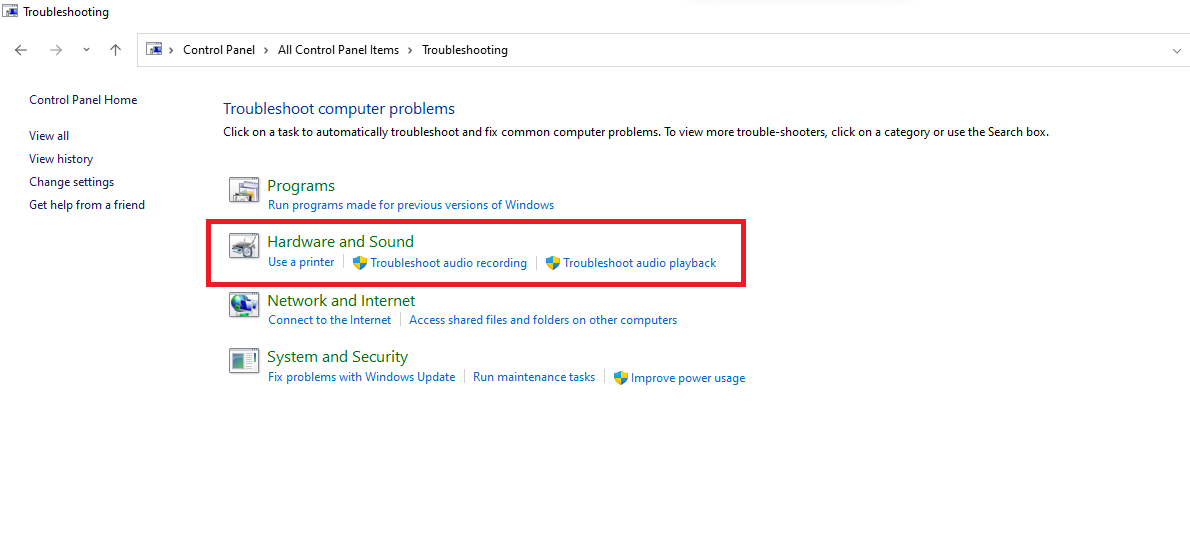
- Select the tab that matches the hardware device that’s manifesting the error “Code 45.”
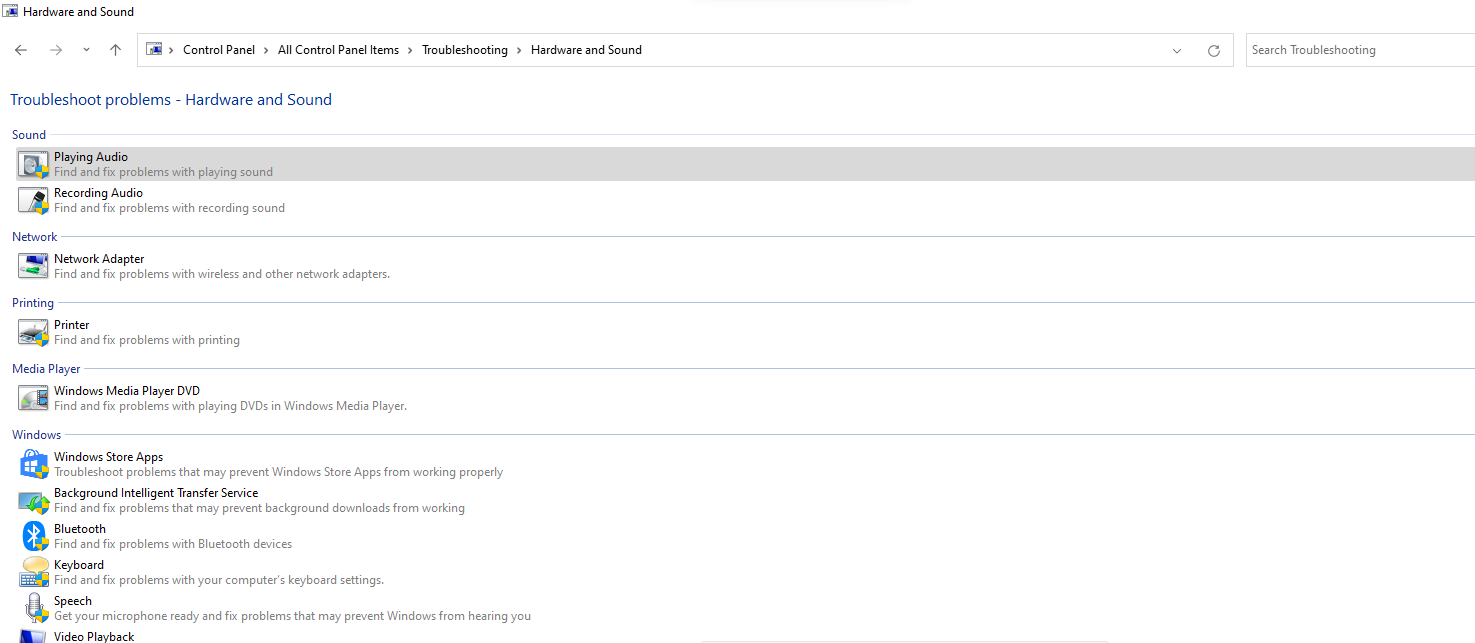
- Click the Next button and allow the troubleshooter to run scans.

- Select any suggestion from Microsoft.
Solution 9: Resolve system file issues with the DISM tool and System File Checker
Remember, we mentioned that the error “Code 45” could arise because of corrupt or missing system files as well as damaged registry entries? System File Checker (SFC) is a helpful Windows tool that you can use to replace these crucial system files and subsequently regain their corresponding registry entries.
It works in tandem with the Deployment Image Servicing and Management (DISM) tool, which ensures that all the necessary replacement files are available and up to date.
Therefore, we will run the DISM scan first, after which we will initiate the SFC scan.
Here’s how to run the DISM and SFC scan to fix Device Manager’s “Code 45” error:
- Click the Start icon on your taskbar and then type cmd in the search bar.
- Run the Command Prompt as an administrator.
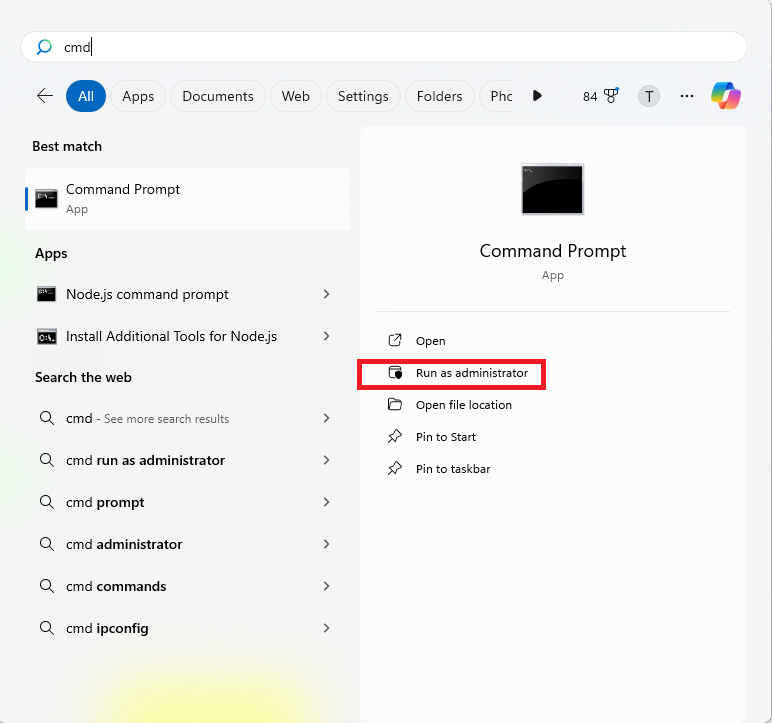
- Click the Yes button on the User Account Control prompt to confirm the action, allowing CMD to make changes to your computer.
- Type or copy and paste the following command into the CMD window and hit
Enteron your keyboard to run it:
DISM /Online /Cleanup-Image /RestoreHealth
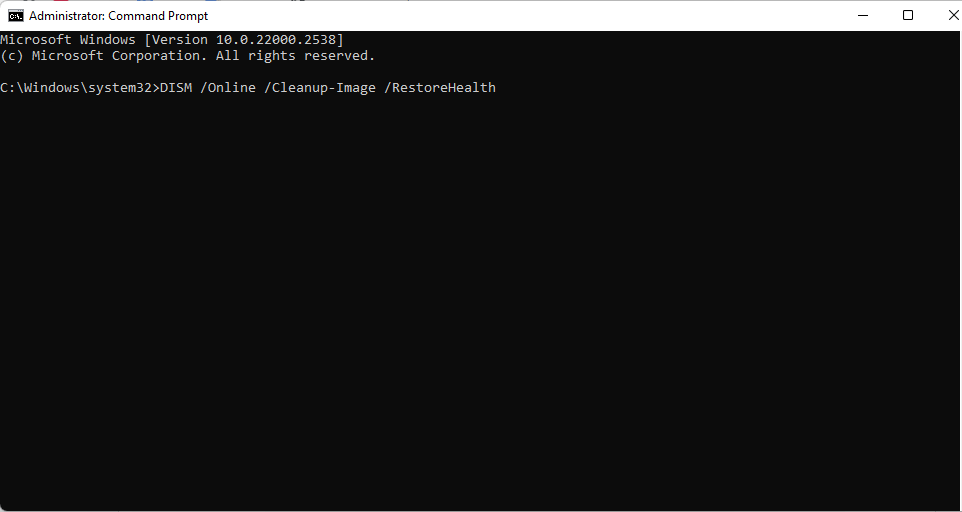
- Wait for the process to complete.
- Now, go ahead and initiate the SFC scan. Type in the following command and hit
Enteron your keyboard to run it:
sfc /scannow
- After the scan is complete, restart your computer.
Once this fix is done, the Device Manager “Code 45” connection error often goes away, allowing your hardware device to function normally once again.
Solution 10: Check the system drive with the CHKDSK command
CHKDSK (Check Disk) is another built-in Windows tool you can use in the Command Prompt window to fix the error “Code 45.”
CHKDSK is effective because it clears out hard drive issues that could stop drivers from working. To use it, do the following:
- Run the Command Prompt as an administrator.
- Type chkdsk.exe /f /r and press
Enteron your keyboard.
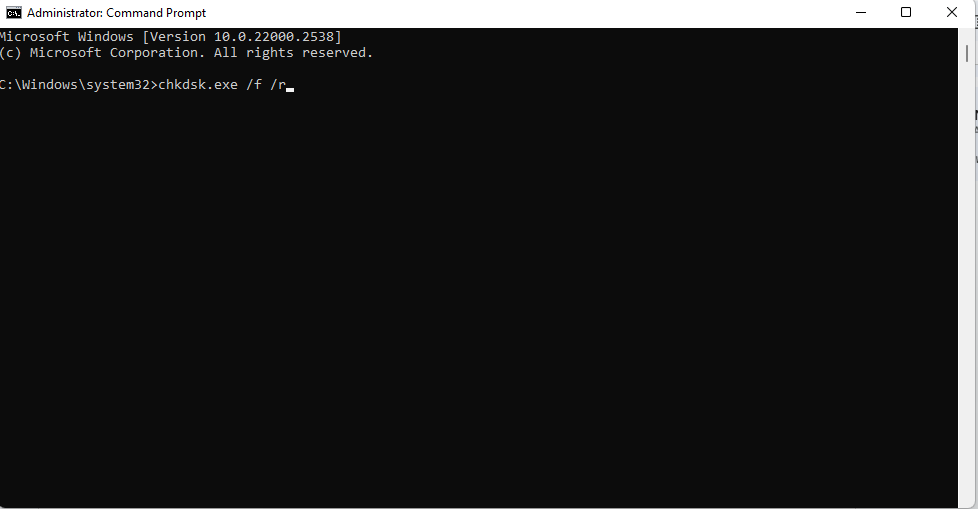
- If you are using your computer for something else, the Command Prompt will ask if you want to reschedule the CHKDSK process. Just tap Y on your keyboard and restart your computer to run the CHKDSK process.
Once you restart your Windows computer, check whether your device now works.
Specific Device Issues and Solutions for “Code 45”
If the “Code 45” error is stopping you from using your Intel Wireless-AC adapter, Bluetooth device, or webcam, you may have to perform some additional troubleshooting procedures before or after you’ve tried the primary solutions previously shown.
What to do if the Bluetooth option is not showing on Windows
On Windows 10 and 11, you might find that the Bluetooth option is no longer available on your PC. Even when you go to Bluetooth & Devices in the Settings app, you won’t find any means to turn your Bluetooth on or off. It may even happen that the Bluetooth adapter is not listed in Device Manager in the first place.
The following solutions will help:
Fix 1: Show hidden devices and scan for hardware changes in Device Manager
- Press the
Windows + Rhotkey to open the Run dialog. - Type devmgmt.msc and click OK to open Device Manager.
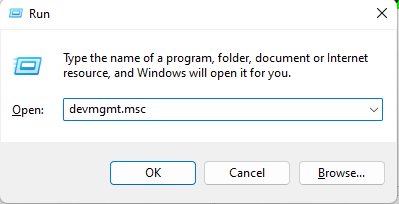
- Select the View menu and click on Show hidden devices.
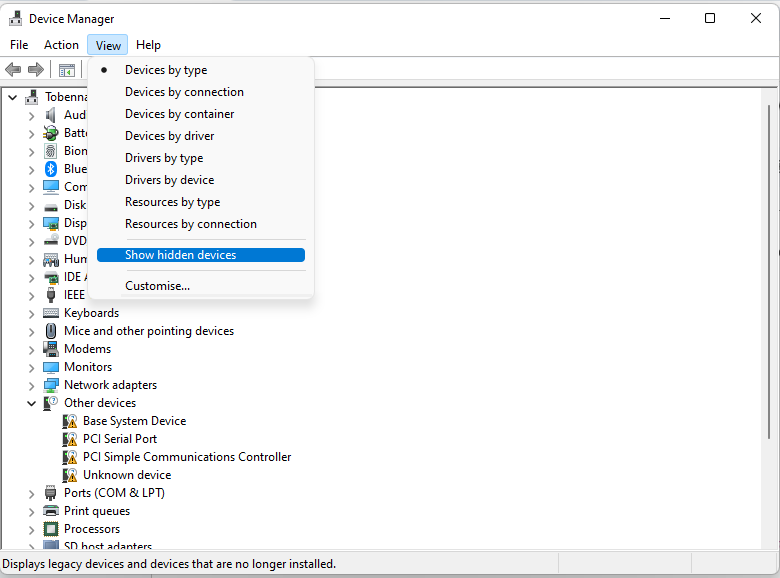
- Click the Action menu and select Scan for hardware changes.
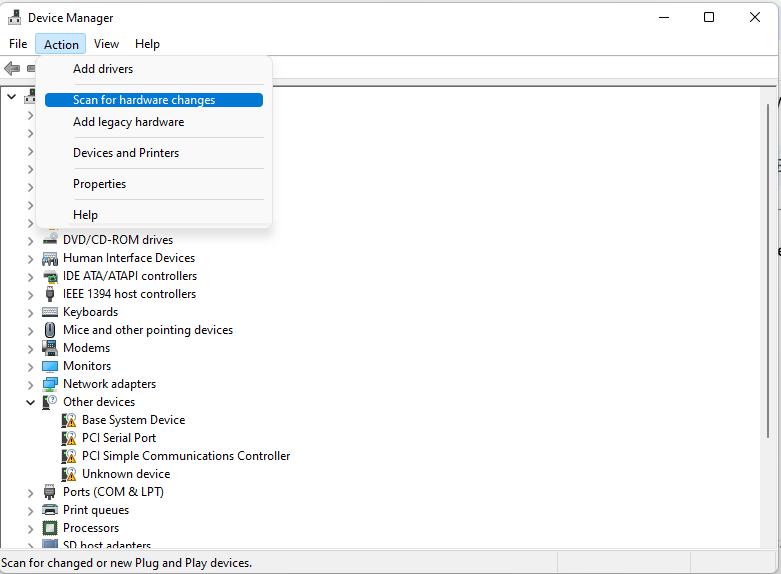
This may suffice in getting Bluetooth back on the list of available devices in Device Manager.
Fix 2: Enable Bluetooth Driver Management Service
- Click the Start icon on your taskbar and type services. Then click on the Run as administrator option to open the app.
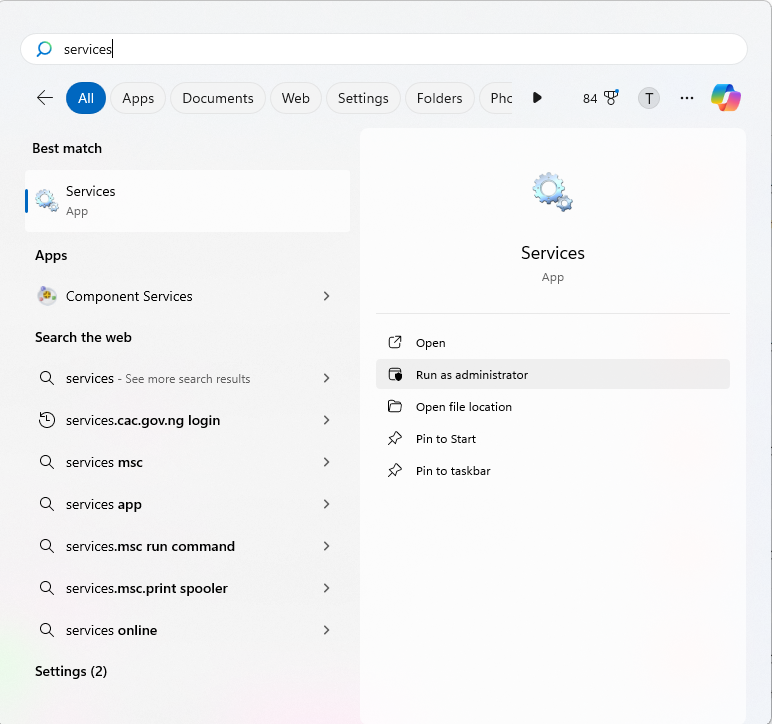
- Once you’re on the Services window, locate all Bluetooth-related services. If the status of Bluetooth Driver Management Service does not say Running, right-click on it and click Start.
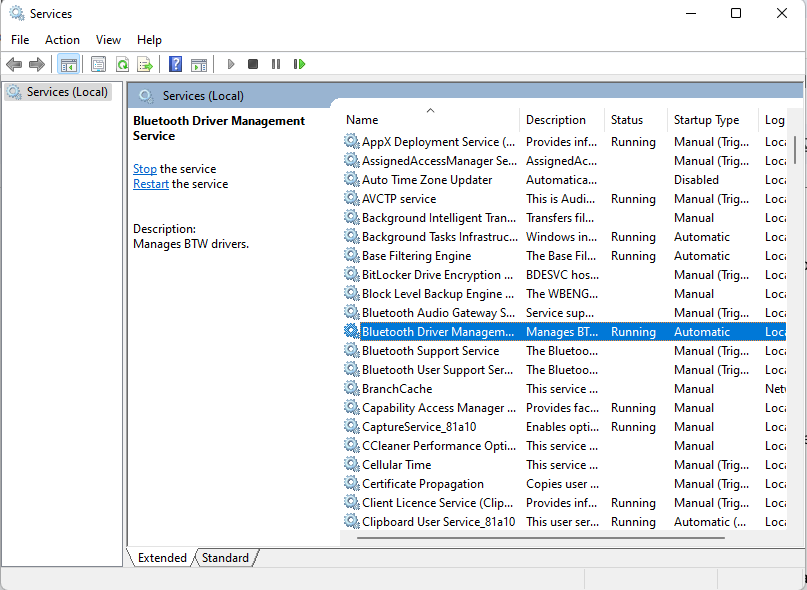
Fix 3: Perform a power flush
- Disconnect your PC from the power source.
- If you have a removable battery, disconnect it as well from the computer. But if the battery is built-in, you may have to seek help removing it or let it discharge completely so that the PC turns off.
- Once all the power sources have been removed or drained, unplug any peripheral still attached to the computer.
- Now, press and hold the power button on your PC for up to 30 seconds.
- Put back the battery (if removable) and plug the charger back in.
- Turn on the PC now. You should be able to find the Bluetooth option on your computer once again.
What to do if your webcam shows “Code 45”

If your computer’s camera is not responding and is showing “Code 45” in Device Manager, the following methods will enable you to get it working again:
Fix 1: Check whether the camera is enabled in the camera app permissions
- Click the Start icon on our taskbar and type camera in the search bar.
- Click on App settings from the options on the right.
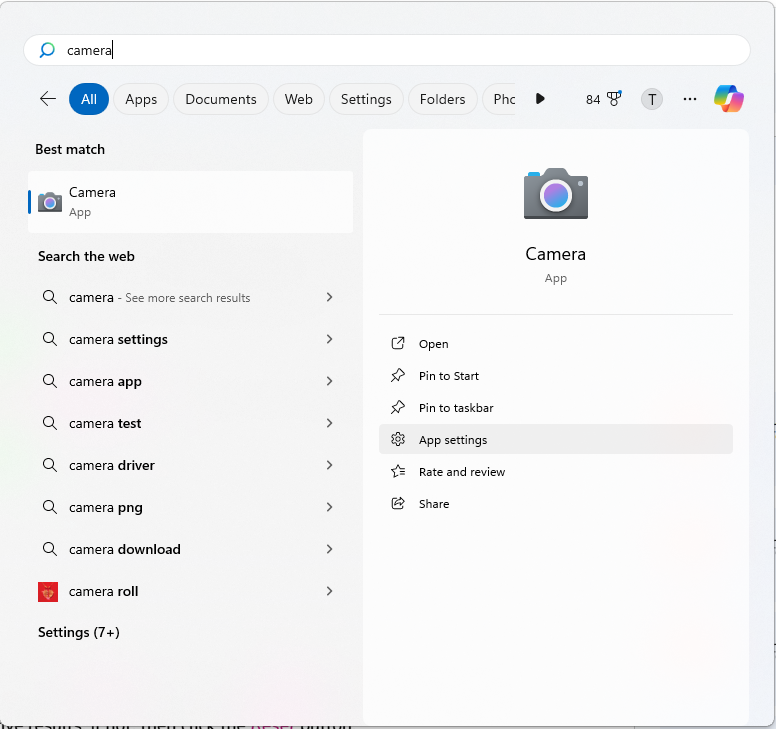
- Under App permissions, see that the camera is toggled on.
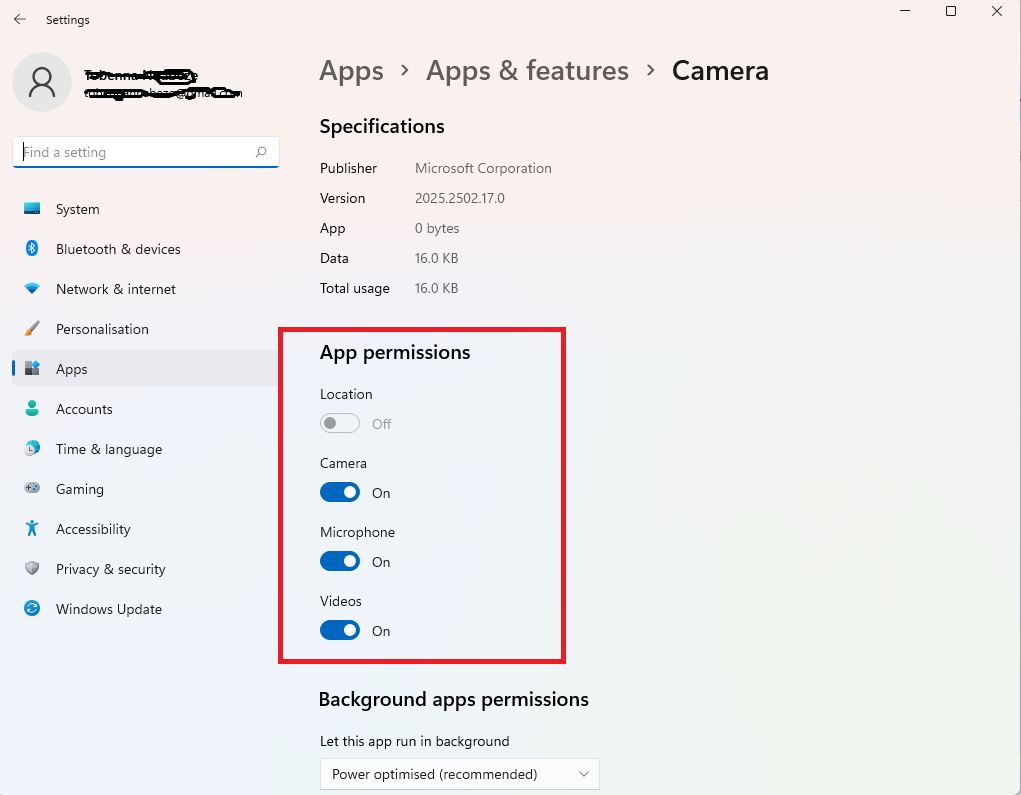
- Scroll down to Reset and first click the Repair button. See if that’d yield positive results. If not, then click the Reset button.
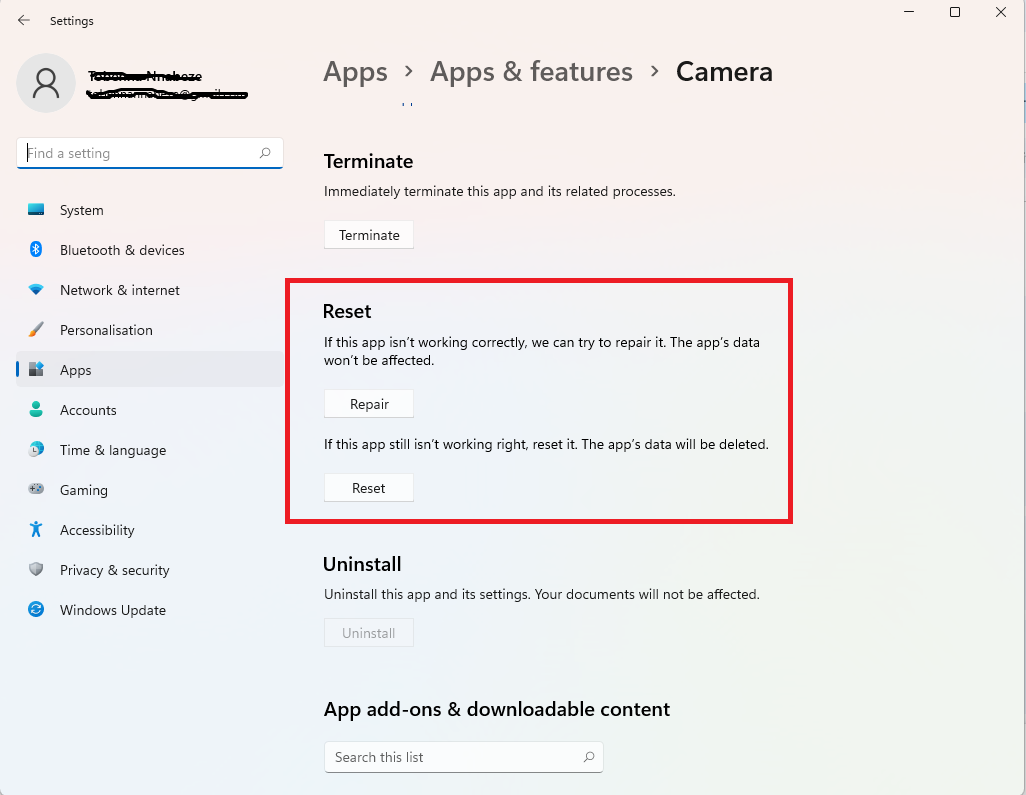
Some PCs, such as MSI and ASUS, also have a camera switch key. And you can activate the camera by pressing the Fn + F6 hotkey on your keyboard. It could also be Fn + F4 or Fn + F10 for some PCs.
Fix 2: Check camera privacy settings
- Click on the Start icon on your taskbar and type camera privacy settings. Then click on the option to open it.
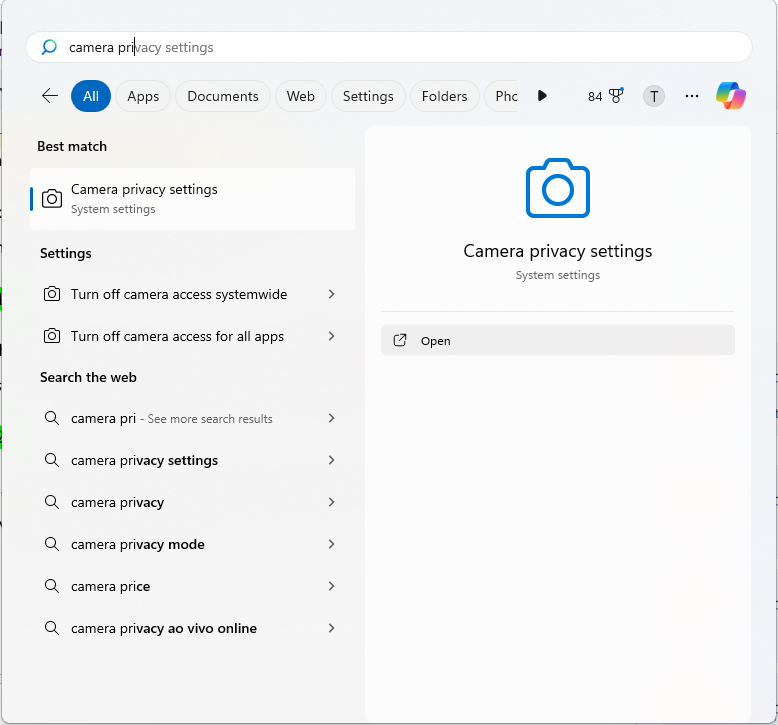
- On the main window, ensure that the Camera access option and the Let apps access your camera option are both toggled on.
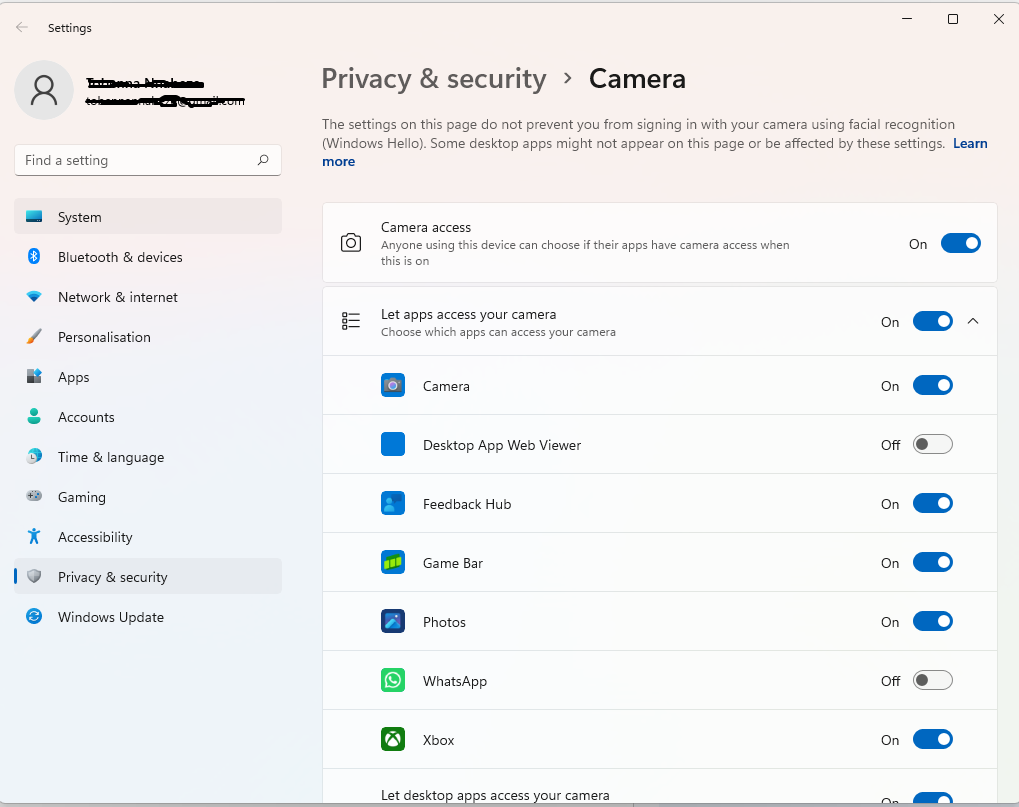
- Also, enable camera access in the list of apps for any app you may want to give access to your camera.
Fix 3: Update BIOS/UEFI firmware and restore default settings
Updating your PC’s BIOS/UEFI firmware could be all you need to make Device Manager’s “Code 45” go away and get your webcam working again. This process also resets the BIOS/UEFI settings, providing a clean slate and ensuring that there are no suboptimal settings preventing your camera from functioning normally.
You can use the specialized maintenance utility on your PC to easily update the BIOS firmware. For example, HP Support Assistant for HP PCs, Dell SupportAssist for Dell PCs, or Lenovo Vantage for Lenovo PCs.
Fix 4: Run webcam diagnostics using your PC’s specialized utility
You may be able to get your webcam working again with the specialized tool that comes with your specific PC brand.
For example, here’s how to run camera diagnostics using Dell SupportAssist:
- Open the SupportAssist app on your Dell PC.
- Switch to the Support tab.
- Click the Get started button on the Test my hardware category under Take care of your PC with these tools.
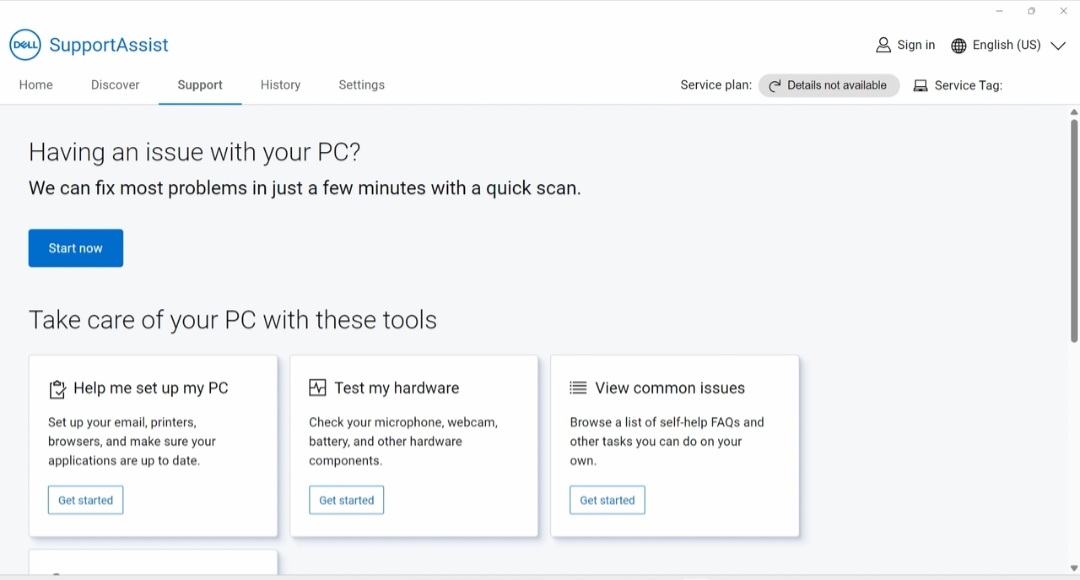
- Expand the I want to troubleshoot my PC option.
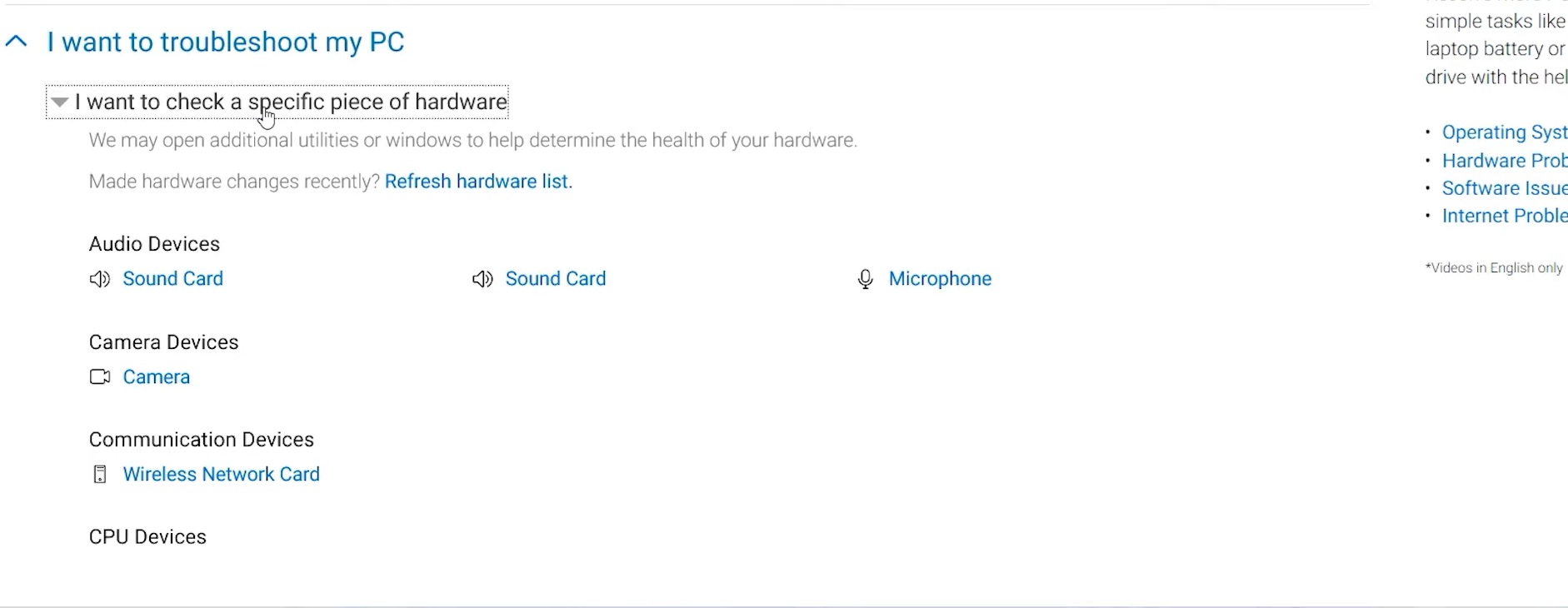
- Click on Camera from the list of devices and follow the onscreen instructions to complete the process.
What to do if your Intel Wireless-AC adapter shows “Code 45”
If your Intel Wireless-AC adapter is not responding and keeps showing “Code 45” in Device Manager, the following solutions will enable you to fix it:
Step 1: Uninstall the Intel Wireless-AC adapter driver
- Open the Run dialog (
Windows + R) and type devmgmt.msc, then hitEnterto open Device Manager.
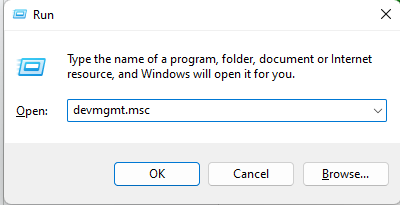
- Locate Network adapters and click the drop-down to expand it.
- Right-click on your Intel wireless network device (for example, Intel Wireless-AC 9560) and click on Uninstall device.
- Check the Delete the driver software for this device (or Attempt to remove the driver for this device) option and click Uninstall.
- You may have to repeat Steps 2 to 4 to ensure that you delete all the redundant driver software.
Step 2: Download and install the latest Intel Wireless-AC adapter driver
- Visit the Intel website.
- Click Wireless under Select Your Product.
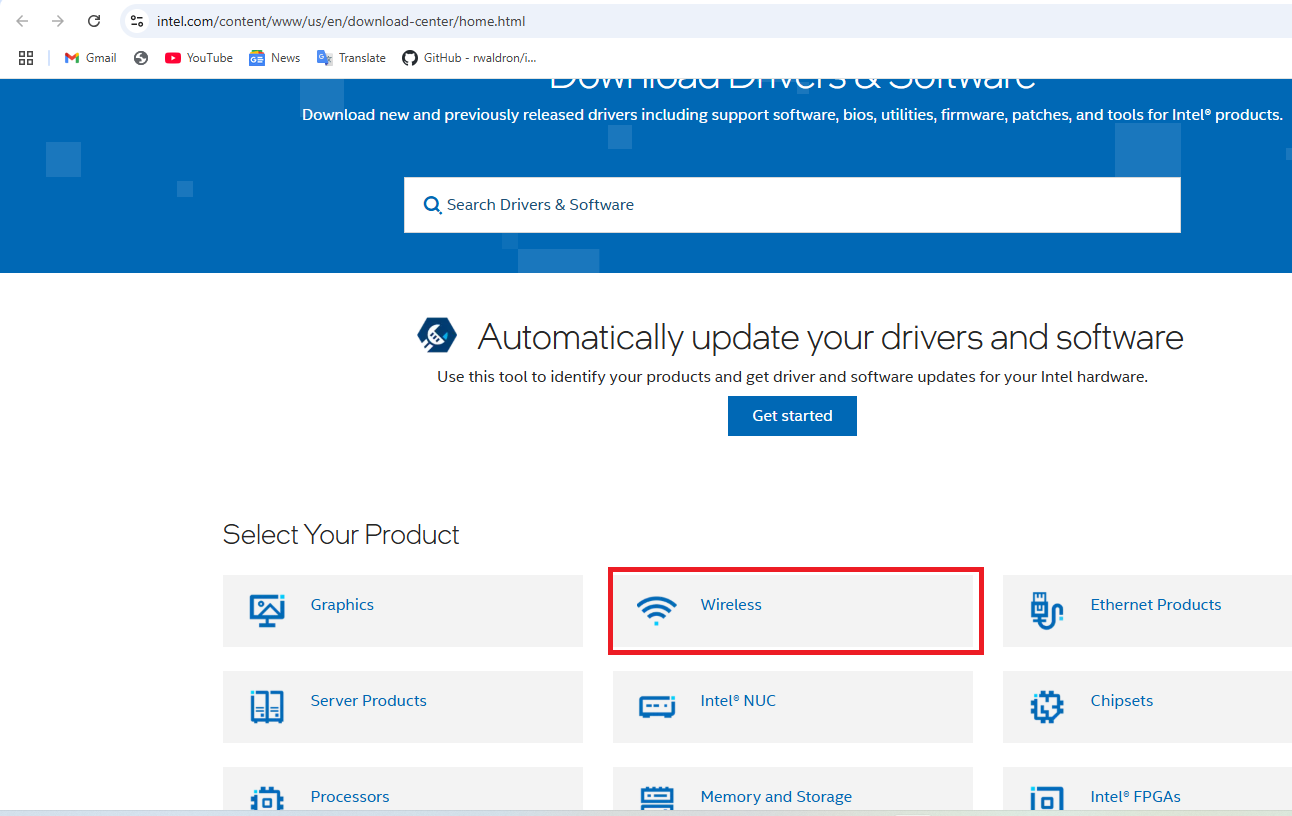
- In the left pane, select Intel Wireless-AC Products under All Products > Wireless.
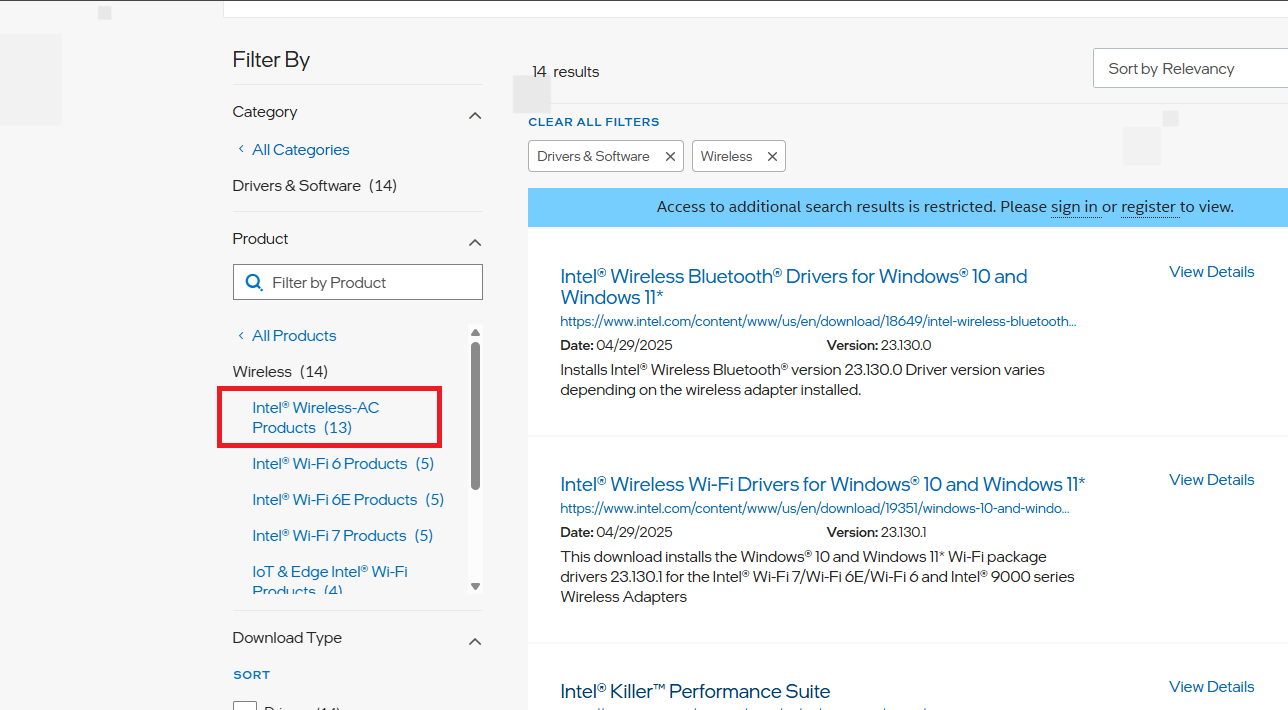
- Select your Intel wireless card series, for example, Intel Wireless Series 9000.
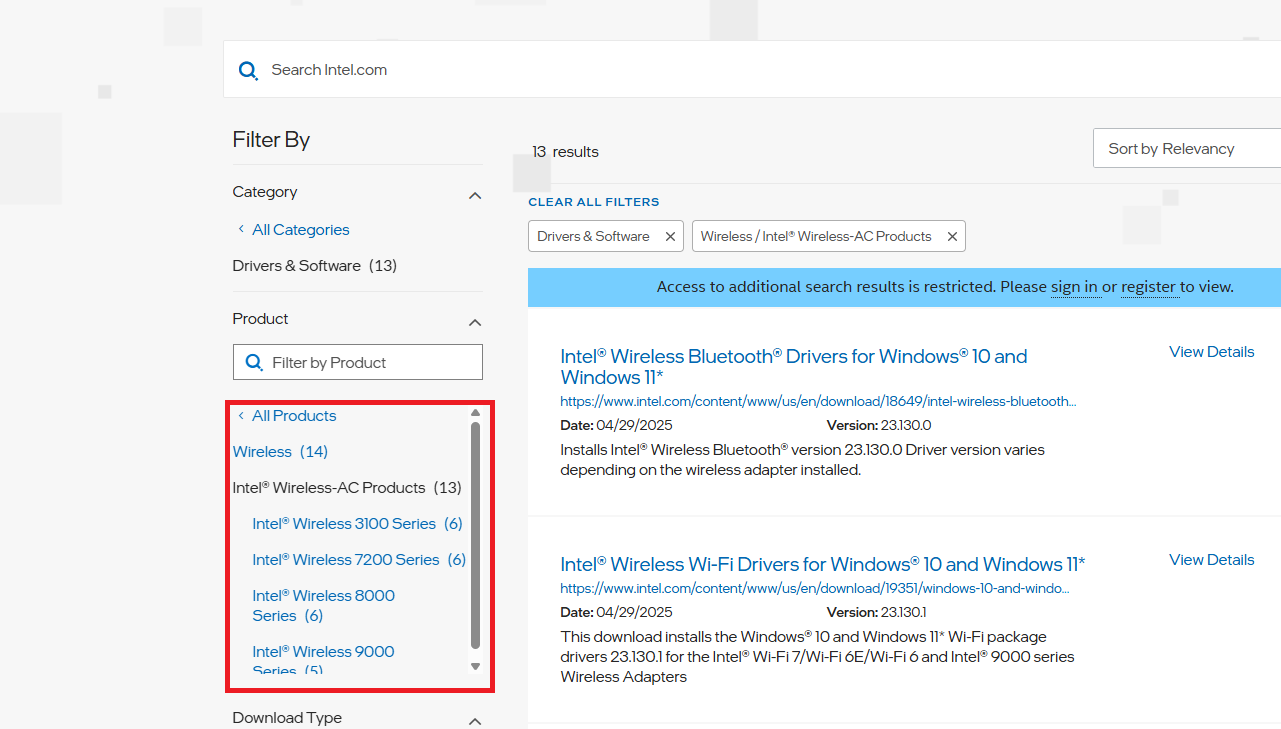
- Now, select your specific Intel wireless-AC version.
- On the right-hand side of the window, click on the latest Intel Wireless Wi-Fi drivers for Windows entry to get the most up-to-date drivers.
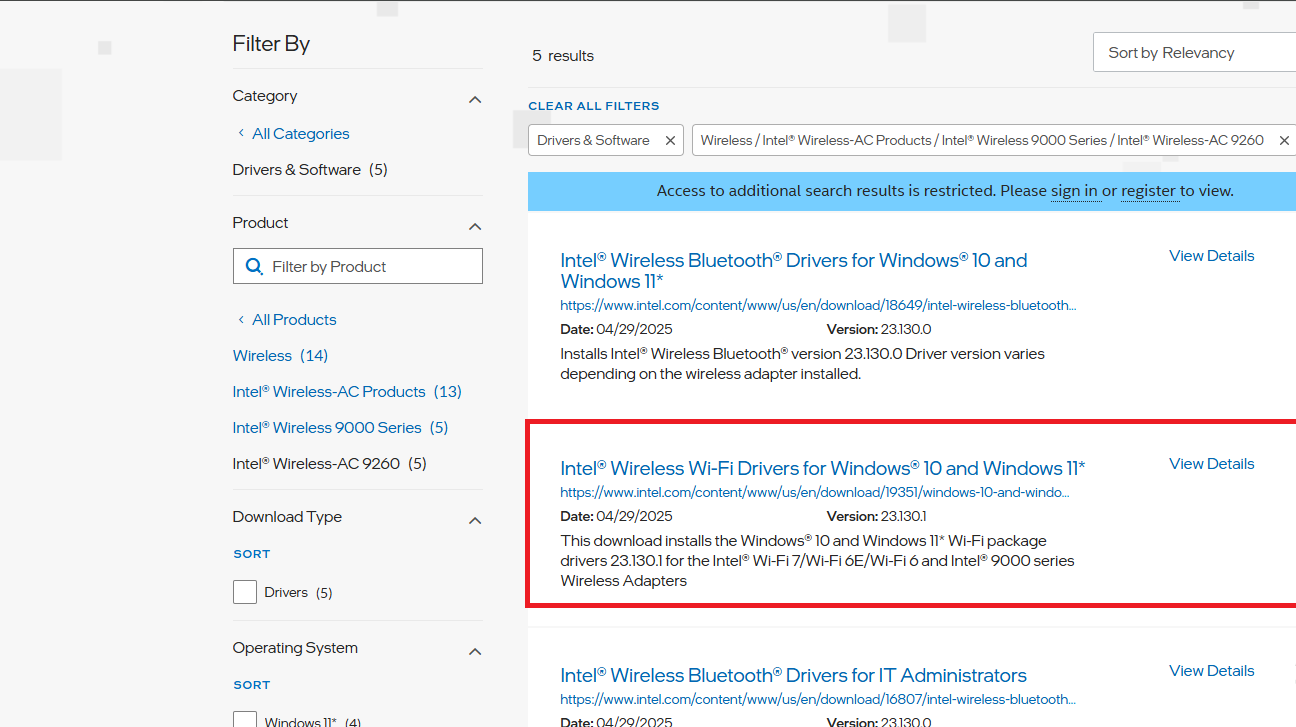
- Double-click on the downloaded file to run the installer.
Step 3: Enable Wi-Fi in BIOS/UEFI settings or restore default BIOS/UEFI settings
You need to ensure that Wi-Fi is enabled within the BIOS settings. Consult your motherboard or PC manufacturer to find the specific procedure for enabling Wi-Fi. If that doesn’t help, try restoring the default BIOS settings or updating the BIOS firmware.
Step 4: Reset network settings
- Click the Start icon on your taskbar and type cmd in the search.
- Click on Run as administrator.
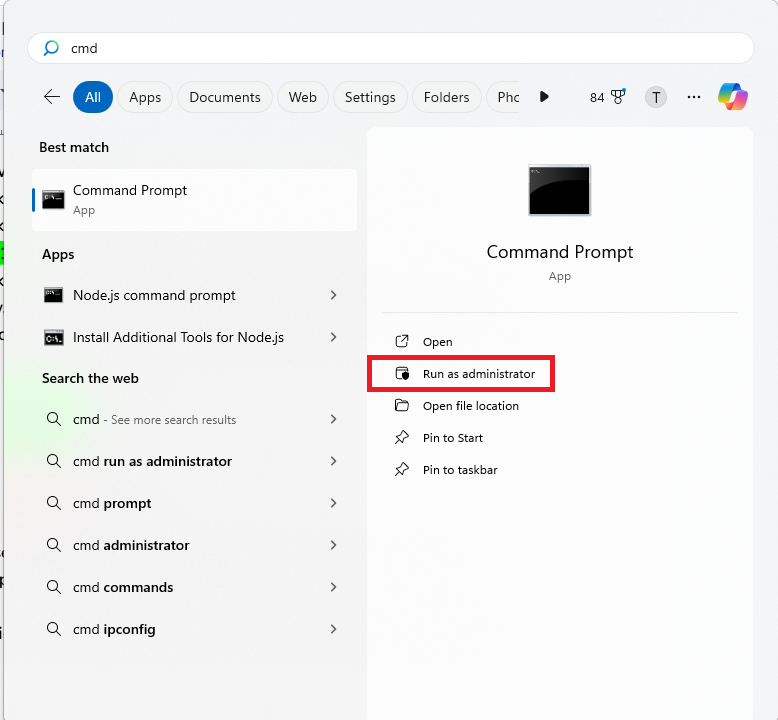
- Click Yes on the User Account Control prompt to confirm the action.
- Now, you have to run the following commands one after the other. You can copy and paste the command and hit
Enteron your keyboard to run it:
netsh winsock reset
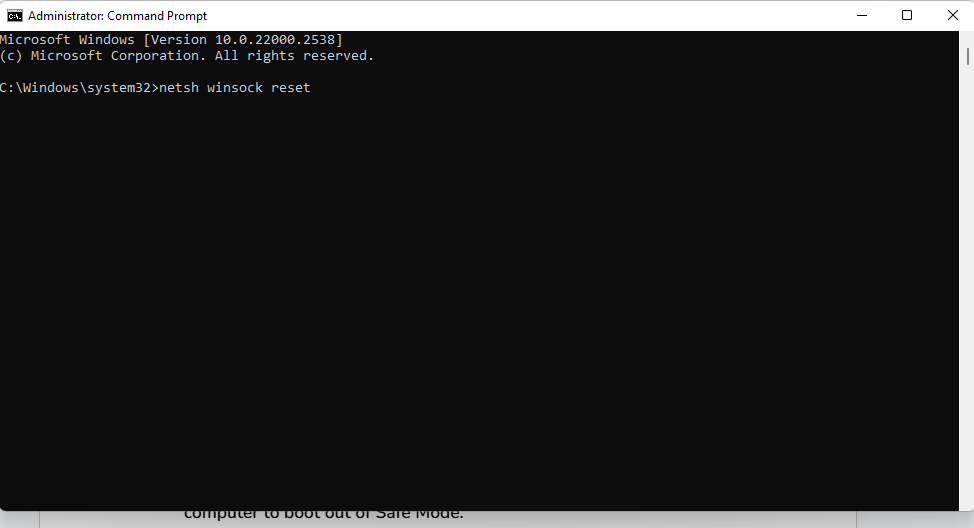
netsh int ip reset
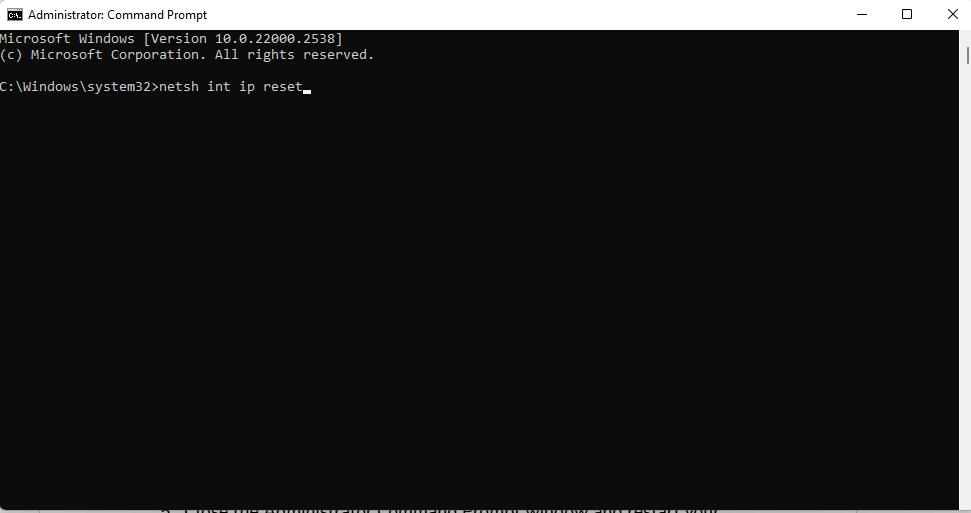
ipconfig /release
ipconfig /renew
ipconfig /flushdns
- Close the Administrator: Command Prompt window and restart your computer.
“Code 45” in Device Manager: Fixed
The Device Manager “Code 45” problem can be quite frustrating when it happens with any of your devices. It mostly has to do with driver or Windows issues. In that case, by the time you’ve attempted one or all of the troubleshooting procedures presented in this guide, you have a good chance of getting rid of the error for good.
However, if it turns out that none of these fixes were able to yield a positive outcome, then you are probably dealing with a hardware fault. You should, therefore, consider replacing the device or the hardware component on your PC. You could also use an alternative device, for example, a USB-connected Bluetooth adapter in place of the internal Bluetooth adapter that came pre-installed in your PC.
Some Windows users may go as far as performing a system restore or resetting the OS just to make double sure that the “Code 45” error is a result of hardware damage.
But a Windows reset is really not necessary if your PC is in good condition and you’re only experiencing “Code 45” on a single hardware device. Then it’s more advisable to get a replacement or use an alternative.
We do hope you’ve found this guide helpful in resolving the error “Code 45” and that your hardware device is functional once more.
We’d like to hear from you. Leave a comment below. Let us know your experience and the fixes that worked for you.
FAQ
There may be any number of reasons for this. If the Bluetooth adapter on your PC is connected via USB, then the “Code 45” error probably means that there’s something wrong with your USB port, thereby causing the connection to be unstable. In that case, it can be fixed by updating your PC’s USB port drivers as well as the Bluetooth drivers.
However, if you’re not using an external Bluetooth adapter, then in addition to updating your Bluetooth drivers, you would have to confirm whether Bluetooth services are running on your computer via the Services utility in Windows.
Power flushing the PC may also prove effective in resolving the Bluetooth “Code 45” error.
If you’re getting the “Code 45” error when trying to connect a hard drive or SSD to your computer, you may be able to resolve it with these methods:
- First of all, reconnect the storage device. That may suffice.
- Update your PC’s USB port drivers.
- Update or reinstall the storage device’s drivers on your PC.
- Run the troubleshooter function in the Windows Settings app.
- Run a CHKDSK scan to fix any issues on the hard drive or SSD. Scan the Windows system drive (Local Disk (C:)) as well to resolve any errors that may be preventing the OS from accessing crucial system files and, therefore, failing to read connected devices.
- Run the DISM tool and an SFC scan to replace any corrupt or missing system files that are preventing the OS from functioning normally.
These may enable the system to recognize your plugged-in devices once again. Otherwise, it could be a hardware fault.
![[FIXED] How to Fix Currently, This Hardware Device Is Not Connected to the Computer. (Code 45) on Windows 10/11](https://www.auslogics.com/en/articles/wp-content/uploads/2024/01/How-to-Resolve-NetBT-4311-Error-568x359.png)
![[FIXED] How to Fix Currently, This Hardware Device Is Not Connected to the Computer. (Code 45) on Windows 10/11](png/how-to-resolve-netbt-4311-error-568x359.png)